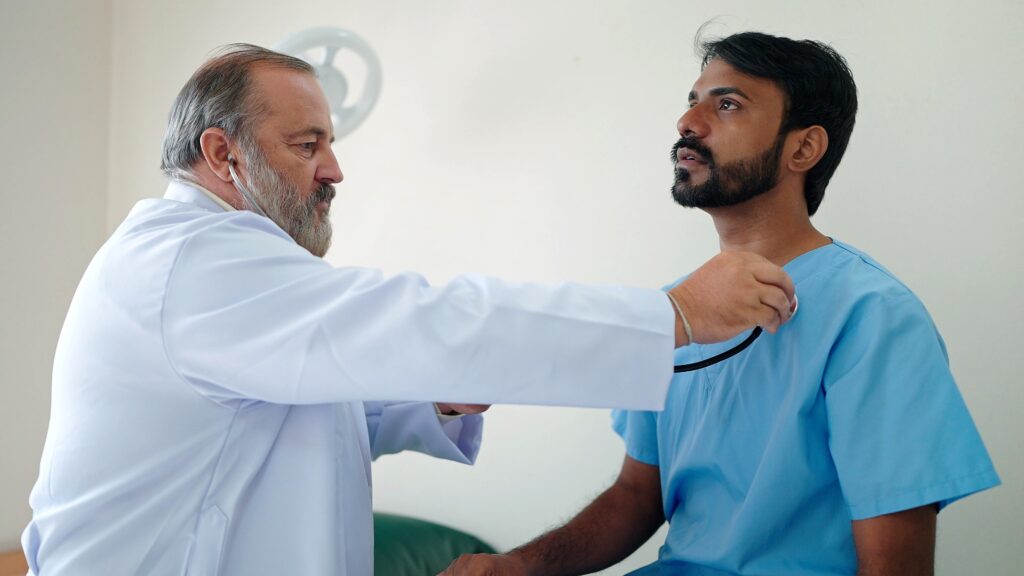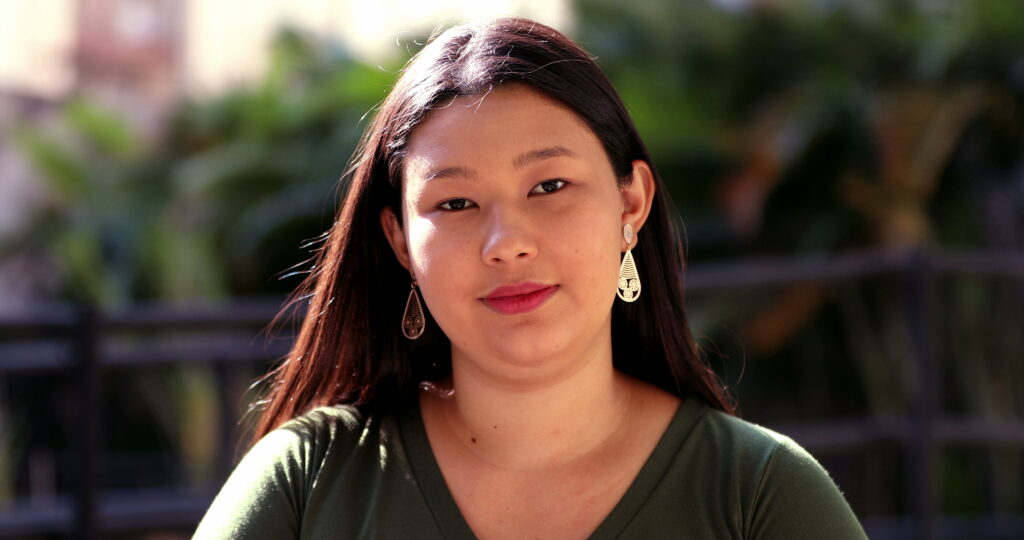When it comes to staying healthy, early detection matters. Cancer can grow silently, often without symptoms, in the early stages.1 That’s why regular screenings are so important. An early diagnosis can lead to better treatment outcomes and improved survival rates.1
By staying proactive with screenings and understanding your risk factors, you can take a powerful step toward protecting your future.
Stay on top of important cancer screenings.

What is cancer?
Cancer happens when abnormal cells in the body grow uncontrollably.5 These cells can form tumors and spread to other parts of the body if not found and treated early. There are many types of cancer, and each one affects the body differently. You can stay ahead of cancer with important screenings.
What is a cancer screening?
A cancer screening checks for cancer before a person has any symptoms. Most cancer screenings take place in a clinic or doctor’s office, but some can be done at home. These tests may include the following:1
- Physical exam and health history: A doctor checks your body for any unusual signs, such as lumps or changes in appearance, and reviews your medical history.
- Lab tests: Samples of blood or tissue can help doctors find cervical, colorectal and other cancers.
- Imaging tests: Mammograms, colonoscopies and CT scans can help check for signs of cancer.

Cancer screenings are a powerful tool for protecting your health. When cancer is found early, it may be easier to treat or cure.
Start by talking to your doctor about what cancer screenings are right for you based on your age, sex, race/ethnicity and family history. (Screenings are most often based on sex assigned at birth and current organs.) If family members have had cancer, it could add to your risk.1
Victor’s preventive care story: Love in action
For Victor, it took his daughter’s heartfelt plea to get the preventive care screenings he needed. Sometimes we all need a little nudge from the ones we love to protect the future we hold dear.
Common types of cancer to screen for
These are the most common cancers that may call for routine screenings:

Check with your health plan or doctor to learn which screenings are covered by your health insurance.
Cancer screening recommendations
Based on your age, sex assigned at birth and risk factors, certain screenings should be part of your routine preventive care.2 Here’s a general guide to when people at average risk should get screened.*
Colorectal cancer
Age to begin screening: 45
Screening frequency
Every 5–10 years through imaging (usually a colonoscopy); every 1–3 years using an at-home test
Breast cancer
Age to begin screening: 40
Screening frequency
Every 1–2 years through imaging (usually a mammogram)
Lung cancer
Age to begin screening: 50,
with extensive smoking history
Every year if you have a history of smoking
Cervical cancer
Age to begin screening: 21
Screening frequency
Every 3–5 years at a doctor’s office3
Prostate cancer
Age to begin screening: As early as 40, based on individual risk
Screening frequency
Blood test every 1–2 years at a doctor’s office, though this varies based on family history and overall risk
Skin cancer
Age to begin screening: 18
Screening frequency
Yearly self-exam follow-up with a doctor if you find an unusual mole or bump4
*If you have a family history of cancer, certain genetic factors or other health conditions that increase your risk, talk to your doctor about when and how often you should get screened.
What to know for you and your loved ones
Cancer affects all groups of people, but risk factors and screening rates vary. Knowing these differences can help you take charge of your health.

African American/Black communities
Compared to other groups, African American/Black people have a higher risk for many cancers.6 One way to stay on top of your health is to plan regular screenings.
Check for prostate cancer.
Finding cancer early can be lifesaving for African American/Black men. They have nearly 70% higher rates of prostate cancer diagnosis.7 It’s important to take action by scheduling a prostate screening and knowing your family history.
Schedule routine mammograms.
Finding out early increases survival rates for African American/Black women, who often face more aggressive forms of breast cancer.6 Getting routine screenings is a vital way to stay healthy.
Keep up with regular cervical cancer screenings.
African American/Black women have a 22% higher rate of cervical cancer diagnosis than non-Hispanic white women.8 When diagnosed at an early stage, the five-year relative survival rate is 91%.8 Regular screenings can help catch cancer early.
Screen for colorectal cancer.
Colorectal cancer rates are 20% higher for African American/Black people than non-Hispanic white people in the U.S.9 Colonoscopies are a vital way to find colorectal cancer before it progresses.

Hispanic/Latino communities
Cancer is the leading cause of death for Hispanic/Latino people in the U.S.10 That’s why it’s important to know about your risk factors. Get regular screenings to stay in control of your health.
Schedule prostate exams early.
Prostate cancer is the most common cancer among Hispanic/Latino men, at a rate of 25%.11 Talk to your doctor about when to start screening.
Stay ahead of breast cancer.
Breast cancer is the most commonly diagnosed cancer among Hispanic/Latina women.11 Regular screenings are vital to help find cancer early.
Get screened for colorectal cancer.
Colorectal cancer is one of the most commonly diagnosed cancers among both Hispanic/Latino(a) men and women.11 Talk to your doctor about your risk and the screening options that are right for you based on age and family history.
Keep up with regular cervical cancer screenings.
Hispanic/Latina women have a 36% higher incidence of cervical cancer than non-Hispanic white women.11 When diagnosed at an early stage, the five-year relative survival rate is 91%.9 Regular screenings can help catch cancer early.

Asian American/Pacific Islander communities
Studies show that compared to other racial/ethnic groups, Asian American/Pacific Islander individuals are less likely to be up to date with many cancer screenings.12 Stay proactive with your health to find cancer early.
Get screened for colorectal cancer.
Colorectal cancer screening rates for Asian American/Pacific Islander individuals are 16% lower than for non-Hispanic white Americans.12 Talk to your doctor about your risk and the screening options that are right for you based on age and family history.
Stay up to date with lung cancer screenings.
Lung cancer is the leading cause of cancer death for Asian American/Pacific Islander men and women.12 Being proactive about regular screenings can be lifesaving.
Keep up with regular mammograms.
Breast cancer is the most common cancer among Asian American/Pacific Island women.12 Talk to your doctor about routine screenings for early detection.
Schedule prostate exams early.
The most diagnosed cancer for Asian American/Pacific Islander men is prostate cancer.12 Regular screenings can help catch cancer early.
Resources and tools
Ready to make the next step in your health journey? Your future needs you, and a healthier tomorrow starts with the actions you take now. Explore these tools to maintain your health, prevent illness and lower health care costs.
Use personalized tools
Access health information anytime, anywhere.
Download the myCigna App:

This information is for educational purposes only. It is not medical advice. Always consult your doctor for appropriate examinations, treatment, testing and care recommendations. Any third-party content is the responsibility of such third party. Cigna Healthcare® does not endorse or guarantee the accuracy of any third-party content and is not responsible for such content. Your access to and use of this content is at your sole risk.
Cigna Healthcare products and services are provided exclusively by or through operating subsidiaries of The Cigna Group.
- Cigna Healthcare. “Cancer Screening Overview (PDQ®): Screening – Patient Information [NCI].” Knowledge Center. Last revised October 20, 2023. https://www.cigna.com/knowledge-center/hw/medical-topics/cancer-screening-overview-ncicdr0000453888
- American Cancer Society. “American Cancer Society Guidelines for the Early Detection of Cancer.” Last revised November 1, 2023. https://www.cancer.org/cancer/screening/american-cancer-society-guidelines-for-the-early-detection-of-cancer.html
- U.S. Preventive Services Task Force. “Draft Recommendation Statement, Cervical Cancer: Screening.” December 10, 2024.https://www.uspreventiveservicestaskforce.org/uspstf/draft-recommendation/cervical-cancer-screening-adults-adolescents
- MedLinePlus. “Skin Cancer Screening.” National Library of Medicine, National Institutes of Health (NIH). Last updated December 15, 2022. https://medlineplus.gov/lab-tests/skin-cancer-screening/
- American Cancer Society. “What Is Cancer?” Last revised March 31, 2025. https://www.cancer.org/cancer/understanding-cancer/what-is-cancer.html
- Centers for Disease Control and Prevention (CDC). “Cancer and African American People.” February 13, 2025. https://www.cdc.gov/cancer/health-equity/african-american.html
- American Cancer Society. Cancer Facts & Figures 2025.Last reviewed 2025. https://www.cancer.org/content/dam/cancer-org/research/cancer-facts-and-statistics/annual-cancer-facts-and-figures/2025/2025-cancer-facts-and-figures-acs.pdf
- American Cancer Society. “Survival Rates for Cervical Cancer.” Last revised January 16, 2025. https://www.cancer.org/cancer/types/cervical-cancer/detection-diagnosis-staging/survival.html
- American Cancer Society. Cancer Facts & Figures for African American/Black People 2022–2024. 2022. https://www.cancer.org/content/dam/cancer-org/research/cancer-facts-and-statistics/cancer-facts-and-figures-for-african-americans/2022-2024-cff-aa.pdf
- CDC. “Cancer and Hispanic or Latino People.” February 13, 2025. https://www.cdc.gov/cancer/health-equity/hispanic-latino.html
- American Cancer Society. Cancer Facts & Figures for Hispanic/Latino People 2024–2026.2024. https://www.cancer.org/content/dam/cancer-org/research/cancer-facts-and-statistics/cancer-facts-and-figures-for-hispanics-and-latinos/2024/2024-2026-cancer-facts-and-figures-for-hispanics-and-latinos.pdf
- American Cancer Society. Cancer Facts & Figures for Asian American, Native Hawaiian, & Other Pacific Islander People 2024–2026. 2024. https://www.cancer.org/content/dam/cancer-org/research/cancer-facts-and-statistics/aanhpi-cancer-facts-and-figures/aanhpi-cff.pdf